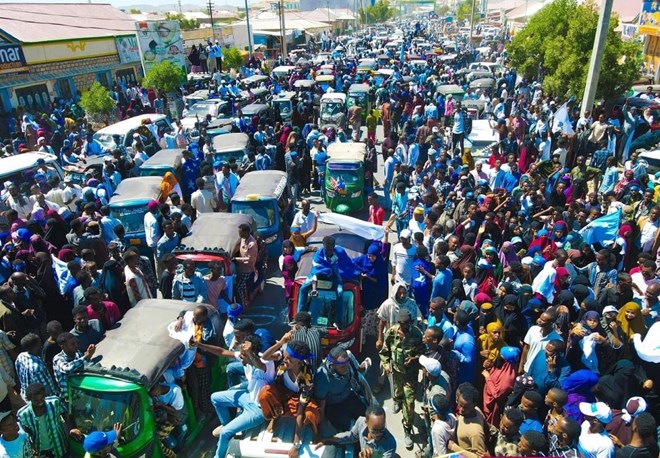By Mahdi Warsama
September 18, 2023

What happened in and around the city of Laascaanood between December 6, 2022, and August 25, 2023, is one of the most impactful historical events in Somalia for the 21st century so far. A group of idealistic and daring youth called "Jamaahiirta" (borrowed Arabic term meaning the masses) decided to take on and challenge once formidable Somaliland control of Laascaanood, the capital of the Sool region in northern Somalia and consequently, the rest of SSC-Khaatumo territories. At the time, no one gave them any chance of succeeding, given the fact that they had no weapons, organizational structure, or the backing of any powerful entity. Yet, after around two months of street demonstrations and strategizing, they had more than what they were dreaming of and became a formidable foe against Somaliland. Within a few months, Jamaahiirta youth got the backing of all SSC-Khaatumo Garaads (traditional leaders), the majority of Dhulbahante soldiers among the Somaliland army switched sides, all Dhulbahante members of the Puntland army joined them, and SSC-Khaatumo diaspora communities started to organize to support them, and eventually evicted Somaliland forces from SSC-Khaatumo territories. In this article, I will explore a few lessons we can learn from this daring mission.
Entrenched Power Structures in Somalia are Shaky at Best
Some of the most significant hallmarks of success are dreaming big, steadfastness, and challenging the status quo. The Jamaahiirta youth had all those qualities. They didn't believe the conventional wisdom that Somaliland was here to stay or was too powerful to be challenged. They often outwitted Somaliland through adaptation, perseverance, and media savviness. They effectively exposed all the weaknesses of Somaliland's security forces, its unequal clan power structures, and the myths of its viability of becoming a sovereign state in the future. The lesson for the rest of us is that any entrenched interest group, seemingly powerful entity, or above-the-surface power dynamics in Somalia are not that powerful. Instead, they are benefiting from the timidness of the Somali public. Once they get challenged, they will crumble like eggshells.
Somali Masses Still Hold the Keys to a Positive Change
I am not advocating for the Somali masses to rise or take arms against their leaders, but, using Jamaahiirta as an example, the Somali masses everywhere can control their destiny by organizing and demanding a positive change. Another good example is how the people of the Hiiraan region liberated their territories from Al-Shabaab by organizing themselves for the end goal of liberating their territories. In many instances, we, the Somalis, let bad actors control our public affairs and then complain about it. We supported the destructive warlords in the 1990s. We allowed Al-Shabaab to slaughter us in the 2000s. We support things that are obviously wrong and unjustifiable. Just as the Jamaahiirta youth did it in Laascaanood, we can steadfastly demand a positive change in our public affairs.
Brutal Crackdown Doesn't Work
The Somaliland decision to underestimate and ignore the Jamaahiirta youth demands was detrimental to their ability to control the situation. There was no attempt by the Somaliland authorities to contain the situation through peaceful means and dialogue. The heavy-handedness of their approach added fuel to the fire. The lesson for all Somali entities is that public discontent can only be addressed through peaceful means and dialogue, or it will transform into an armed conflict.
The Reawakening of the Clan Sentiment & Grievances is the Best Organizing Principle for Somalis
The conflict between the Jamaahiirta youth and Somaliland made the difficult task of uniting the Dhulbahante clan and the wider Harti clan easily attainable. It is mind-boggling how swiftly the Jamaahiirta youth, who were not tribalistic before the conflict, united their clan behind the common cause of defeating Somaliland. After February 6, 2023, Dhulbahante/Fiqishinni declaration of removing all Somaliland forces from SSC-Khaatumo territories, followed by 22 days of fighting, all Harti subclans spontaneously joined the fight in March 2023. One Puntland official told me even Said Abdullahi Deni, the president of Puntland state who wasn't interested in joining the battle at the beginning, couldn't control his forces. They were going to the battlefield in droves without his blessing. In other words, the soldiers' loyalty to their clan superseded their loyalty to the Puntland army. The lesson for all Somali entities is to be careful about reawakening the giant sleeping Somali clan sentiment. It is too dangerous to be messed with.
Drawing Administrative Borders Within Somalia Without Consent Will Not Work
The SSC-Khaatumo and Somaliland conflict and the Hiiraan and Hirshabeelle dispute are case studies for drawing envisioned Somalia federal borders. While it is impossible to have only clan-based borders everywhere, it is not possible to ignore clan borders and dynamics either. Every federal state in Somalia must respect the clan dynamics in order to function. Adjoining communities and constituencies together in a single nation-state can only work at free will and through reconciliation. The lesson for all involved is that we must go back to the drawing board and figure out how to create functioning federal states within Somalia without causing a perpetual conflict.
Mahdi Warsama can be reached at [email protected]